Published: December 28,2023
By Yu Shuyi

Editor’s note: China’s diplomacy has been in full swing this year after the country resumed exchanges with the world in an orderly manner. Since the start of the year, Chinese President Xi Jinping has been on a tight diplomatic schedule. What is the significance of Xi’s diplomacy? How does it influence the global landscape? Chinese Diplomacy in Action is a five-part series exploring the effectiveness of China’s diplomatic activities in the past year. The third essay is on the Belt and Road Initiative.
Kribi, a small coastal town in Cameroon’s south region, is gradually becoming a key logistical hub in central and western Africa. The Kribi Deep Seaport, which began operations in 2018, today offers countries in the region convenient access to the sea. With an annual throughput of 250,000 twenty-foot equivalent units (TEUs) and over 1 million tons of bulk cargo, the first large deep seaport in Cameroon is becoming increasingly important to trade in the region, and is set to serve as one of the fulcrums of the economic transformation of Cameroon and that of the region at large. As a part of China’s support for other countries under the framework of the Belt and Road Initiative (BRI), it is a shining example of this project.
It was only a little over a decade ago that things were very different in Kribi. At the time, Douala served as the main port of Cameroon. The Douala Port was nowhere near big enough to serve the needs of a growing Cameroonian economy. However, while Kribiwas a natural first-choice for building a new, modern and large-scale port, authorities needed to provide the local community with good livelihood opportunities and a better quality of life to convince them to relocate from the area where the port would be built.
The first phase of Kribi Deep Seaport project, constructed by China Harbour Engineering Company, in Cameroon, December 9, 2018. /Xinhua
China Harbour Engineering Company, which contracted to build the port, came up with a solution. They offered to build roads linking the port to the new village where the local population would be resettled. This, along with new jobs with competitive wages, convenient transportation, technical and non-technical training and other perks, won over the local villagers.
The local community became a core part of the construction and operationalization of the port. Over 2,000 locals joined the construction initially, and their numbers kept growing over the years. They acquired mechanical and management skills during the course of the project, as well as soft skills like learning English and Chinese, which helped widen the horizon of future economic opportunities available to them.
Alain Patrick Mpila Ayissi, manager of Land development and Environment department of Port Authority of Kribi, described the immediate impact of the port in an interview. “Since the construction works ended in 2014 and the start of port operations in 2018, there has been a notable increase in economic growth. The first indicator is the hikes in the customs revenues as a result of the port,” which jumped from about $1.26 million to practically $250 million per annum, he said.
Boosting infrastructure connectivity and providing access to unimpeded trade are among the core principles BRI projects operate on. The Kribi Deep Seaport has not only helped prepare the groundwork on both fronts, but by bringing local and international stakeholders into the project and fostering close coordination among all parties, it has also displayed policy coordination as per specific needs and ensured long-term financial integration in the region.
By involving the local community, offering them soft skills like languages training, and widening the scope of their interaction with the rest of the world, the project also contributed to stronger people-to-people ties. That’s the reason why China’s BRI is widely welcomed and an epitome of why China’s BRI is an approach to promote global common development.
Examples like the above mentioned are plentiful as cooperation under the BRI framework is so fruitful. The three Belt and Road Forums for International Cooperation have totaled 1,011 practical collaboration projects, a total of six economic corridors are under construction, and 60-plus BRI partner countries have formed more than 1,000 pairs of friendly cities with their Chinese counterparts. The list can go on.
Jeffrey Sachs, a professor and director of the Center for Sustainable Development at Columbia University, lauded the BRI as a tremendous idea, and is “the right thing to do.”
The Rashakai Special Economic Zone under the China-Pakistan Economic Corridor in the northwest Khyber Pakhtunkhwaprovince of Pakistan, May 23, 2023. /Xinhua
As a landlocked country, Mongolia once had only one railway connection with China, but since joining the BRI in 2013, they have been building five railway lines, three of which have already reached the Chinese border. The Mongolian Minister of Road and Transport Development Sandag Byambatsogt acknowledged that the BRI has enabled the countries to exchange their necessities “at a lower cost and in a faster time.”
With the abundance of water sources in the southern part of the country, Argentina is working with China to build the Nestor Kirchner-Jorge CepernicHydroelectric Power Plant. Mariano Musso, director of institutional relations for the project, said that the plant is expected to provide 1.5 million Argentine households with their daily electricity consumption, and reduce oil and gas import expenses of almost $1.1 billion each year.
From the Eurasian continent to Africa and Latin America, “landlocked countries” have become “land-linked countries,” and ample natural resources have been fully used for the common good of people. Countries have gained increasing opportunities to access world markets. The economic globalization process has become more dynamic, inclusive and sustainable.
China’s focus on common development, rather than the development of a few at the cost of others, has been crucial to the success of BRI projects. The initiative has gone through a golden decade with a spirit of openness, inclusiveness and mutual benefit. As it steps into another golden decade with tenacity, the BRI is helping lay the foundations for a global community of shared future.
The author is a researcher of the Institute of Russian, Eastern European and Central Asian Studies at the Chinese Academy of Social Sciences.
cgtn.com
 Africa -China Review Africa -China Cooperation and Transformation
Africa -China Review Africa -China Cooperation and Transformation
